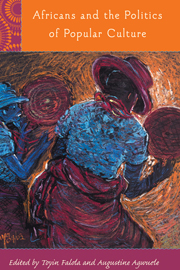Book contents
- Frontmatter
- Contents
- List of Illustrations
- Preface
- Introduction
- 1 From Primitive to Popular Culture: Why Kant Never Made It to Africa
- Part One Politics of Culture in Habitual Customs and Practices
- Part Two Politics of Culture in Popular Representations: Films and Performances
- Part Three Politics of Culture in Popular Texts
- List of Contributors
- Index
- Rochester Studies in African History and the Diaspora
Introduction
Published online by Cambridge University Press: 12 September 2012
- Frontmatter
- Contents
- List of Illustrations
- Preface
- Introduction
- 1 From Primitive to Popular Culture: Why Kant Never Made It to Africa
- Part One Politics of Culture in Habitual Customs and Practices
- Part Two Politics of Culture in Popular Representations: Films and Performances
- Part Three Politics of Culture in Popular Texts
- List of Contributors
- Index
- Rochester Studies in African History and the Diaspora
Summary
Definition and Nature of Culture
Culture can be seen as the shared patterns of habitual behaviors, responses, and ideas that people acquire as members of a society. Each generation passes onto the next its tested ways of being and of doing things in the world. These shared norms and values, from an anthropological perspective, constitute the heritage of members of a given community. However, culture is not static; it is continuously modified in response to changing circumstances. As such, what amounts to culture at any given time and what each society recognizes as its heritage requires continuous documentation, examination, reexamination, explication, and careful reflection with respect to its roles and consequences. Such documentation and explication require a careful definition and delineation of the subject matter of culture, a difficult task as attested by the many definitions of culture and approaches to culture, which vary from any one scholar to another within and across disciplines. Sometimes the dragnet of the scope of culture is cast narrowly to distinguish only between “high” and “low” culture; at other times, it is cast broadly to subsume all observable practices, mental attitudes, and behavioral attitudes within a society. The narrow distinction is mainly one of class; it distinguishes between those restrictive and exclusive cultural productions often attributed to polite society and consumed by the nouveaux riches and those cultural productions that are easily accessible to the masses.
- Type
- Chapter
- Information
- Africans and the Politics of Popular Culture , pp. 1 - 16Publisher: Boydell & BrewerPrint publication year: 2009



